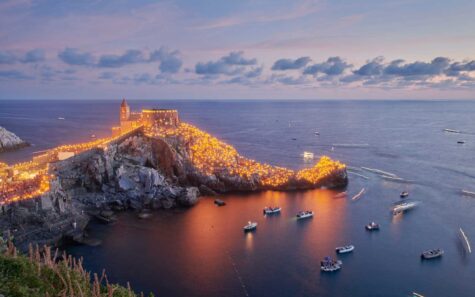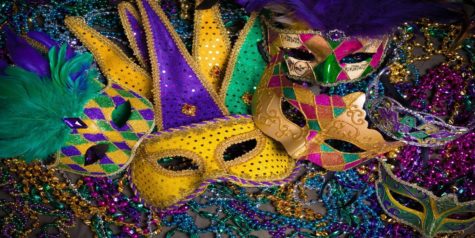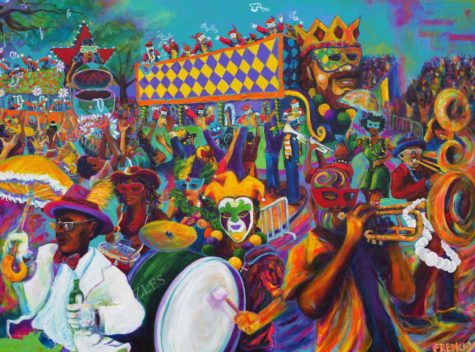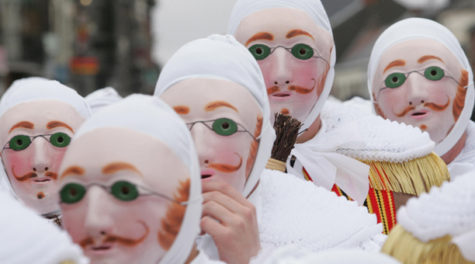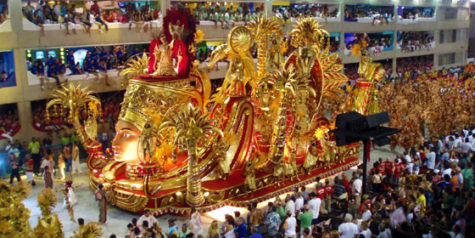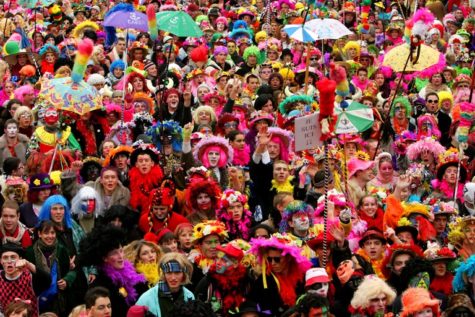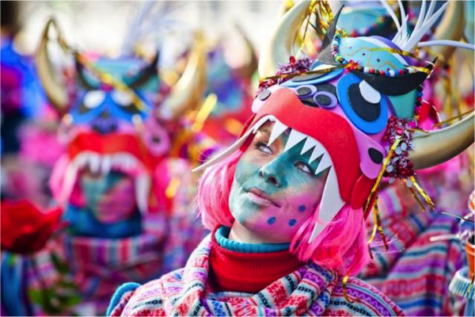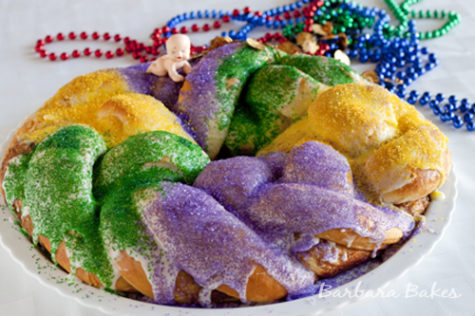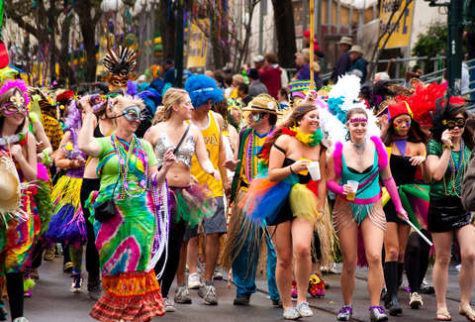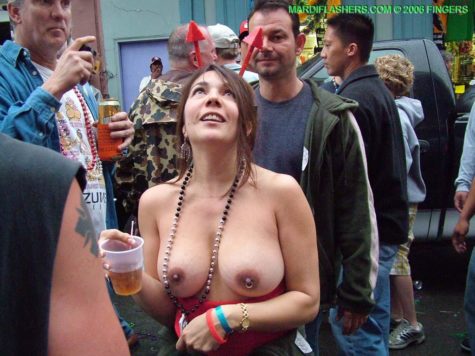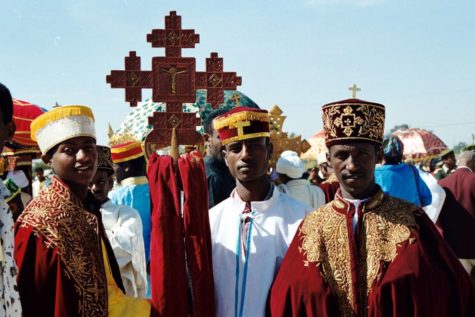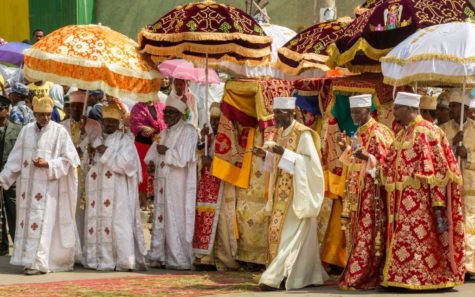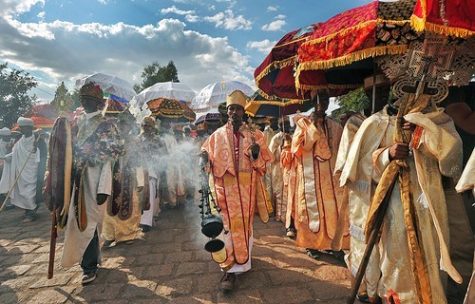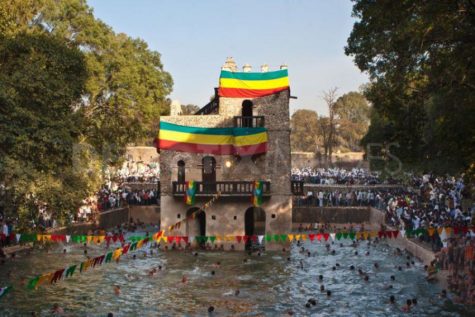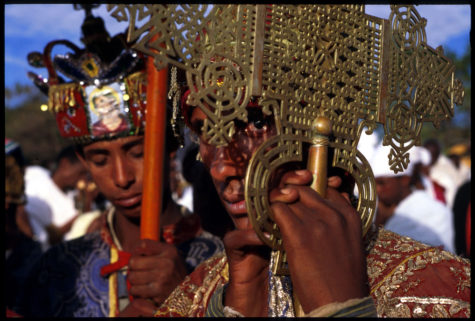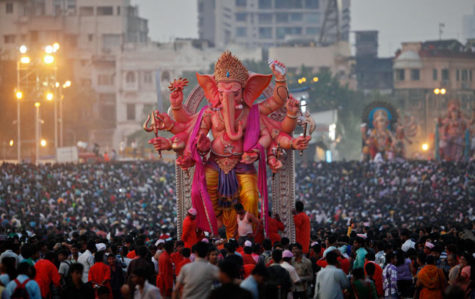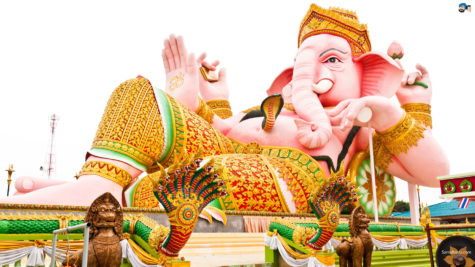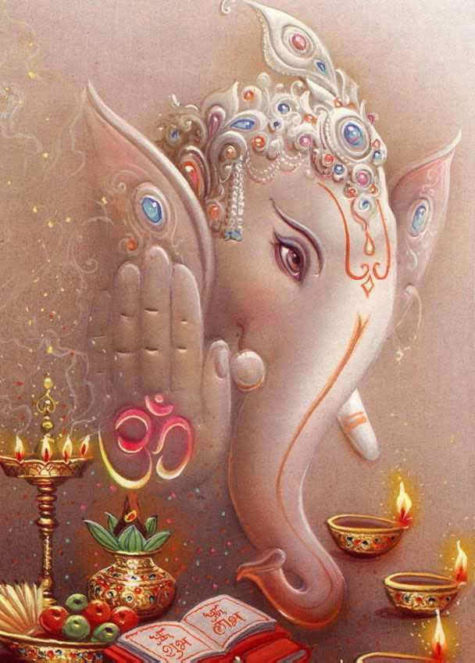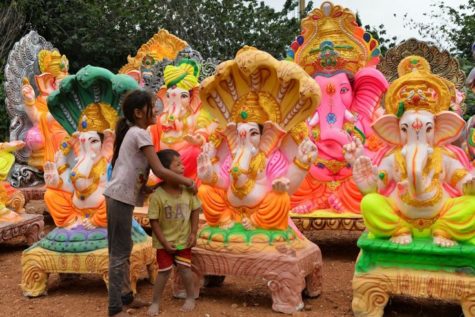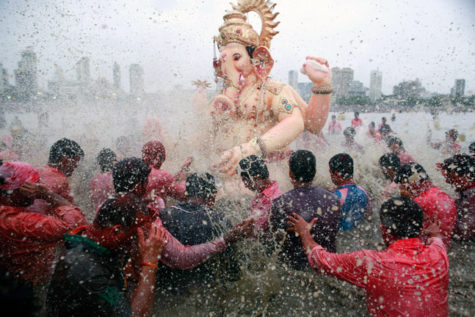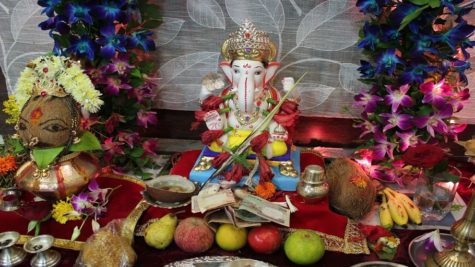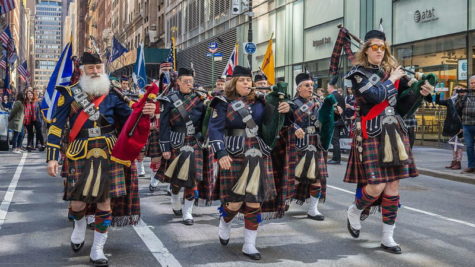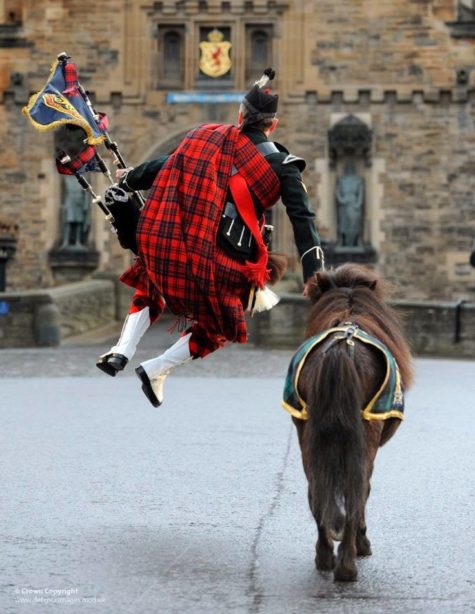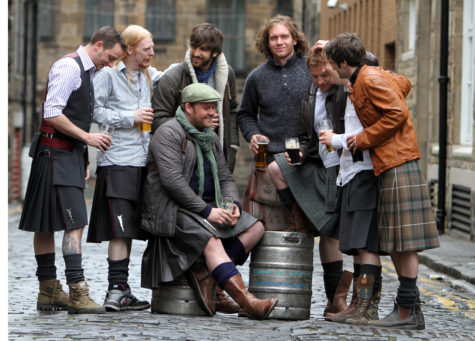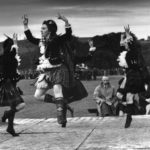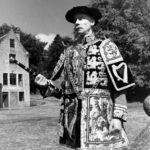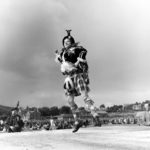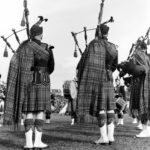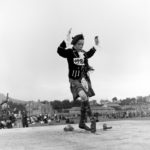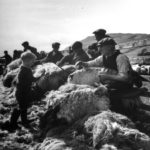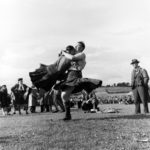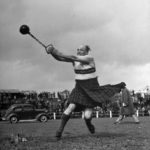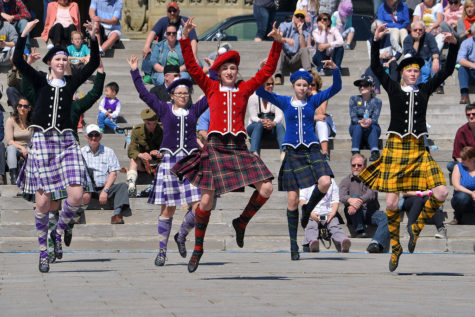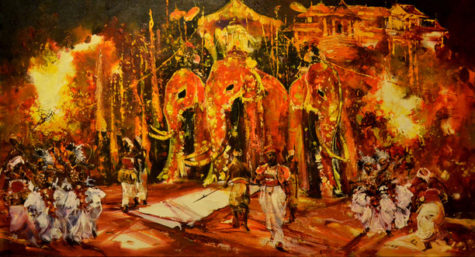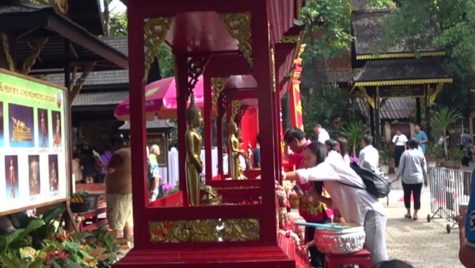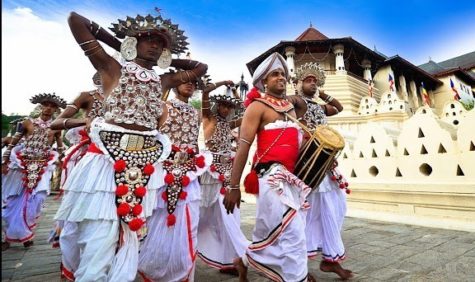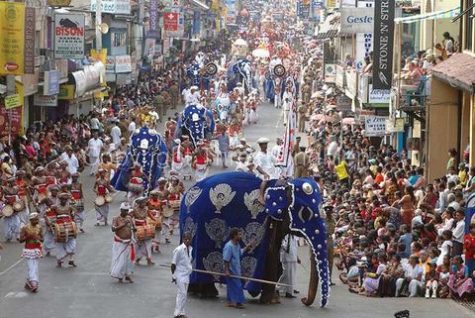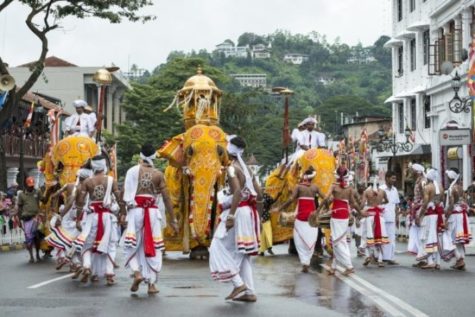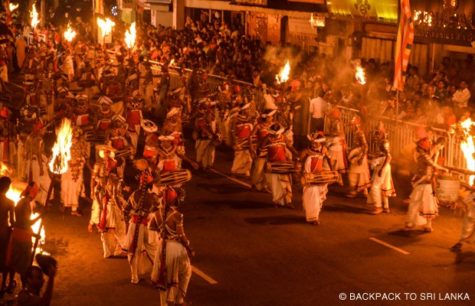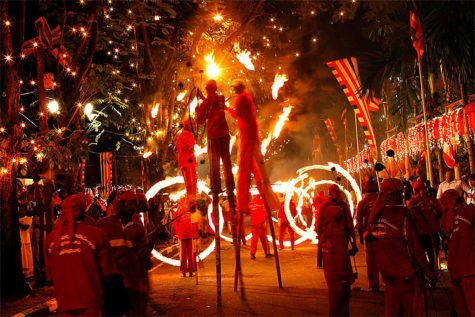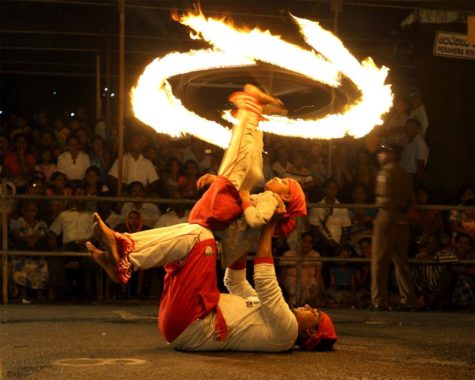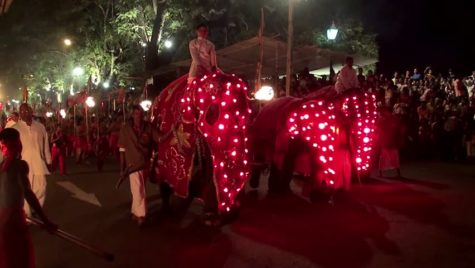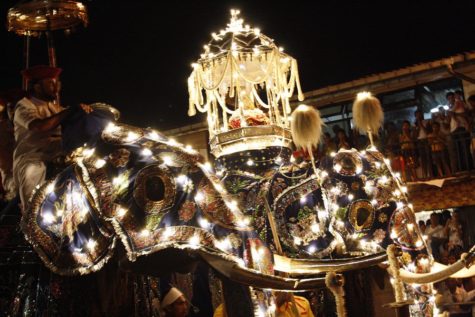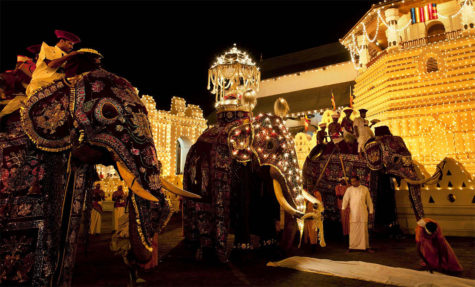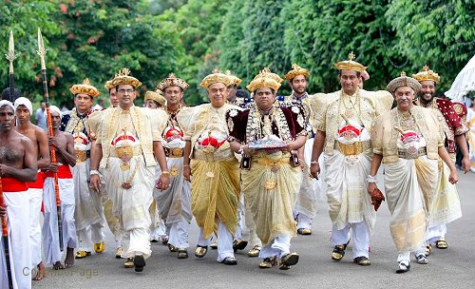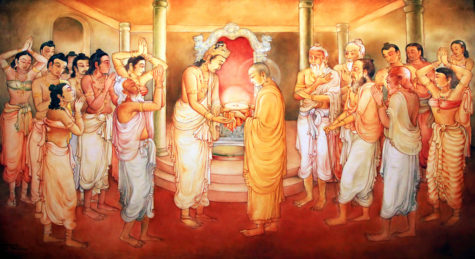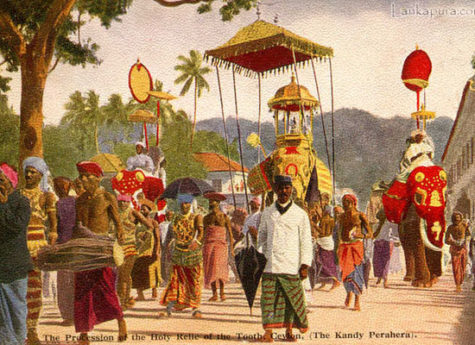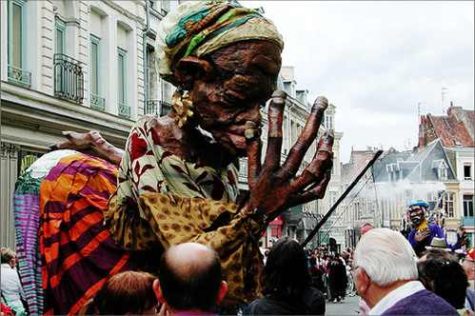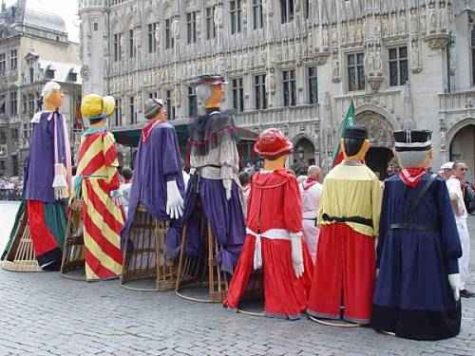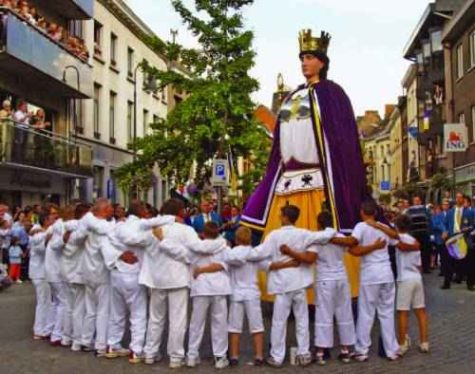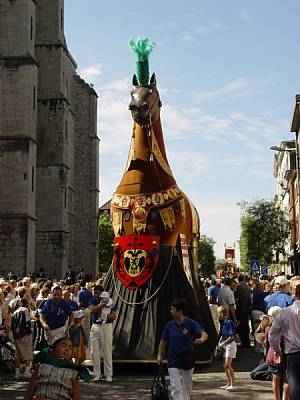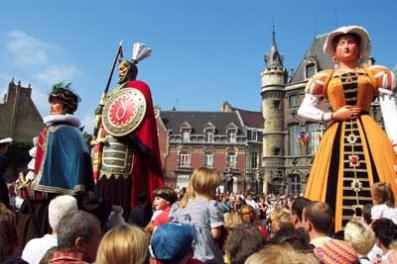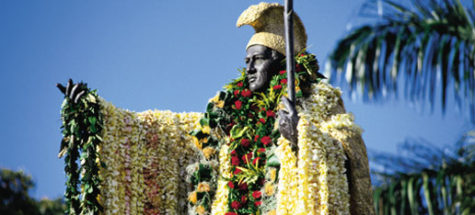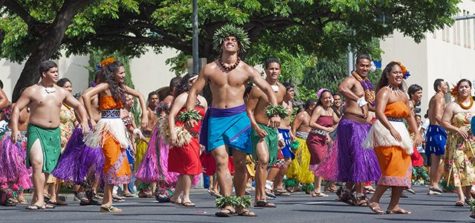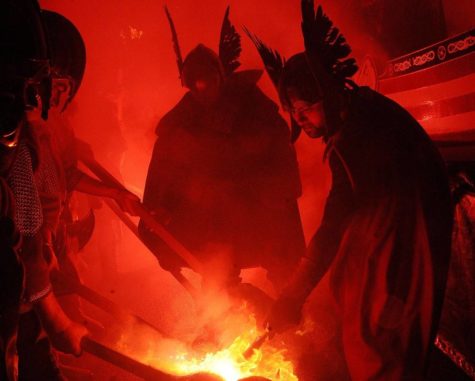Parades
The festival of Nemoralia (aka Festival of Torches) was celebrated by the ancient Romans either on 13–15 August or on the August Full Moon, in honor of the goddess Diana (Diana Nemorensis). This festival was later adopted by Catholics as The Feast of the Assumption.
Ovid describes the celebration thus:
“In the Arrician valley, there is a lake surrounded by shady forests, Held sacred by a religion from the olden times… On a long fence hang many pieces of woven thread, and many tablets are placed there as grateful gifts to the Goddess. Often does a woman whose prayers Diana answered, With a wreath of flowers crowning her head, Walk from Rome carrying a burning torch… There a stream flows down gurgling from its rocky bed…”
On this day, worshippers would form a shimmering procession of torches and candles around the dark waters of Lake Nemi, Diana’s Mirror. The lights of their candles join the light of the moon, dancing in reflection upon the surface of the water. Today’s festival is held in the Greek fashion.
Hundreds join together at the lake, wearing wreaths of flowers. According to Plutarch, part of the ritual (before the procession around the lake) is the washing of hair and dressing it with flowers. It is a day of rest for women and slaves. Hounds are also honored and dressed with blossoms. Travelers between the north and south banks of the lake are carried in small boats lit by lanterns. Similar lamps were used by Vestal virgins and have been found with images of the Goddess at Nemi.
One 1st century CE Roman poet, Propertius, did not attend the festival, but observed it from the periphery as indicated in these words to his beloved:
“Ah, if you would only walk here in your leisure hours. But we cannot meet today, When I see you hurrying in excitement with a burning torch To the grove of Nemi where you Bear light in honour of the Goddess Diana.”
To Do Today
Requests and offerings to Diana may include: small written messages on ribbons, tied to the altar or to trees; small baked clay or bread statuettes of body parts in need of healing; small clay images of mother and child; tiny sculptures of stags; dance and song; and fruit such as apples.
In addition, offerings of garlic are made to the Goddess of the Dark Moon, Hecate, during the festival. Hunting or killing of any beast is forbidden on Nemoralia.
Source: Wikipedia
Mardi Gras is a carnival celebration that begins on Twelfth Night (the Feast of Epiphany) on January 6th and culminates on the Tuesday before Lent. The best known Mardi Gras is in New Orleans, Louisiana where it is a legal holiday.
Mardi Gras is French for Fat Tuesday, the Tuesday before Ash Wednesday. The biggest events happens on this day. The name Fat Tuesday comes from an old custom of parading a fat ox through the streets of Paris on Shrove Tuesday. The term Fat Tuesday also reflects the practice of the last night of eating rich, fatty foods before the ritual fasting of the Lenten season.
Related popular practices are associated with Shrovetide celebrations before the fasting and religious obligations associated with the penitential season of Lent. In countries such as the United Kingdom, Mardi Gras is also known as Shrove Tuesday, which is derived from the word shrive, meaning “to administer the sacrament of confession to; to absolve”
Mardi Gras traditions are rooted in Ancient Greek and Roman customs. Carnival in Rome became popular around the middle of the second century as a way to feast and act wild before the somber days of Lent. They wore costumes and masks. They celebrated Bacchus and Venus and all things glutinous and pleasurable. The Bacchus parade is still held during Mardi Gras in New Orleans.
Mardi Gras in the United States
It’s believed the first American Mardi Gras took place on March 3, 1699, when the French explorers Iberville and Bienville landed in what is now Louisiana. They held a small celebration. Each year, it got bigger with street parties, masked balls, and extravagant dinners. However, when the Spanish took over, the celebrations were banned until Louisiana became a U.S. state in 1812.
On Mardi Gras in 1827, a group of students wearing bright costumes danced through the streets of New Orleans, emulating the revelry they’d observed in Paris. Ten years later, the first recorded New Orleans Mardi Gras parade took place.
In 1872, the official Mardi Gras colors were established as purple, green, and yellow when the Russian Grand Duke Alexis Romanoff came to New Orleans during carnival in pursuit of actress Lydia Thompson. These were the colors of the Romanoff house. Purple stands for justice, green for faith, and yellow for power.
Carnival organizations are called Krewes. The first krewe was the “Mystick Krewe of Comus”, which began in 1857. The second oldest krewe is the “Krewe of Rex”, which started up in 1872. Balls and galas of elaborate and enormous proportion are held every year, but only members of the Kewes may attend.
Mardi Gras parades fill the streets. Beads, coins, balls, cups, and other trinkets are thrown to the crowds. In 1872, the Krewe of Rex, staged a daytime parade in the archduke’s honor. This parade is still held and is the largest of all the parades.
In 1916, Zulu began to parade featuring characters such as King Zulu, Big Shot, and the Witch Doctor. While Rex rules Mardi Gras with a golden scepter and jeweled crown, King Zulu carries a banana stalk and wears a lard can on his head.
Alabama and Mississippi also have Mardi Gras celebrations.
Mardi Gras in Belgium
In the Belgian city of Binche, the Mardi Gras festival is one of the most important days of the year and the summit of the Carnival of Binche. Around 1000 Gilles dance throughout the city from morning until past dusk, while traditional carnival songs play. In 2003, the “Carnival of Binche” was proclaimed one of the Masterpieces of the Oral and Intangible Heritage of Humanity by UNESCO.
Another noteworthy celebration in Belgium is Aalst Carnaval. Mardi Gras is considered the day of the “Voil Janet” or “Dirty Sissy”. Traditionally in Aalst, men dress as their wives or mothers. This custom called “Voil Janet” goes back to the time when Aalst was an industrial time and workers did not have the money to buy dresses. On Mardi Grass the “Voil Janet” gets a parade dedicated to it. Men and woman dressed traditionally get to walk along in the parade, and interact with the viewers.
The word “Voil” in the local dialect, means dirty (= Dutch “vuil”, cognate with English “foul”). For this reason, the parade is sometimes claimed obnoxious, dirty and flat out obscene. Though the parade has mellowed down over the years due to restrictions implemented by the town.
Later that day people gather around an effigy that is lit. This event is paired with a lot of music, emotions and fraternity. The event is known for the fact that almost every person in the crowd starts crying. After that, there is one last night of celebration.
Mardi Gras Around The World
- Brazil
Carnival is the most famous Brazilian holiday. During this time, Brazil attracts 70% of its tourists. Variations in carnival celebrations are observed throughout the multitude of Brazilian cities. Commonality observed among them is the incorporation of samba into the celebrations.
The southeastern cities of Brazil have massive parades that take place in large sambadromes. The Rio Carnival is where two million people celebrate in the city. The city of Salvador holds a very large carnival celebration where millions of people celebrate the party in the streets of the city with a very big diversity of musical styles together.
- Cayman Islands
The Cayman Islands Mardi Gras hosts a popular Monday Food Festival prior to the Fat Tuesday Festivities. Ash Wednesday being a holiday has a daytime party in George Town which coincides with the annual Agriculture Fair which is attended by thousands of residents.
- Colombia
Carnaval de Barranquilla is Colombia’s Mardi Gras celebration. In 2003, it was proclaimed as one of the Masterpieces of the Oral and Intangible Heritage of Humanity by UNESCO.
- Czech Republic
In the Czech Republic it is a folk tradition to celebrate Mardi Gras, which is called Masopust (meat-fast i.e. beginning of fast there). There are celebration in many places including Prague but the tradition also prevails in the villages such as Staré Hamry, whose the door-to-door processions there made it to the UNESCO World Intangible Cultural Heritage List.
- France
Carnival parades take place in many cities such as Nice, Alpes Maritimes, Dunkerque, Granville, Sarreguemines as well as in the French Caribbean islands Guadeloupe and Martinique.
The Nice Carnival is held annually in Nice on the French Riviera. The earliest records establish its existence in 1294 when the Count of Provence, Charles Anjou, wrote that he had passed “the joyous days of carnival.” This may make the Nice Carnival the original carnival celebration. Today the event attracts over a million visitors to Nice every year over a two-week period.
- Germany
The celebration on the same day in Germany knows many different terms, such as Schmutziger Donnerstag or Fetter Donnerstag (Fat Thursday), Unsinniger Donnerstag, Weiberfastnacht, Greesentag and others, and are often only one part of the whole carnival events during one or even two weeks before Ash Wednesday be called Karneval, Fasching, or Fastnacht among others, depending on the region.
In standard German, schmutzig means “dirty”, but in the Alemannic dialects schmotzig means “lard” (Schmalz), or “fat”; “Greasy Thursday”, as remaining winter stores of lard and butter used to be consumed at that time, before the fasting began. Fastnacht means “Eve of the Fast”, but all three terms cover the whole carnival season. The traditional start of the carnival season is on 11 November at 11:11 am (11/11 11:11).
- Italy
In Italy Mardi Gras is called Martedì Grasso (Fat Tuesday). It’s the main day of Carnival along with the Thursday before, called Giovedí Grasso (Fat Thursday), which ratifies the start of the celebrations. The most famous Carnivals in Italy are in Venice, Viareggio and Ivrea. Ivrea has the characteristic “Battle of Oranges” that finds its roots in medieval times. The Italian version of the festival is spelled Carnevale.
- Netherlands
The Netherlands also has a festival similar to Mardi Gras. It’s called Carnaval and is similar to the Venice Carnival. The origin of the word Carnaval is carnem levare which means “to take away meat” in Latin, or carne vale, Latin for “farewell to meat”. It marks the beginning of Lent, leading up to Easter.
The carnival in the Netherlands is mainly held in the southern part of the Netherlands in the provinces of Noord-Brabant and Limburg, some parts of Zeeland and in eastern parts of Twente and Gelderland. As with many popular festivals, people tend to loosen some moral codes and become laid-back or loose, which is based in the ancient role-reversal origins of Carnaval, including dressing in costumes.
- Russia and Ukraine
Both Russia and Ukraine have the festival of Maslenitsa (Масленица, rus.), which on its pagan side celebrates the end of winter and the upcoming summer, and on its Christian side marks the last week before the Great Fasting period before Christian Easter.
The festival includes family gatherings with festive meals and treats of bliny (crepes) that resemble the round shape of sun, and culminates on the weekend with mass outdoors gatherings, festivities and entertaining activities such as pole climbing, where a wheel with variety of presents is affixed on the top of a long pole and the contestants need to reach the top to get them.
Also the festival’s mascot – a feminine figure made out of straw, which symbolizes winter, gets put on fire at the end of the celebration.
- Sweden
In Sweden the celebration is called Fettisdagen, when you eat fastlagsbulle, more commonly called Semla. The name comes from the words “fett” (fat) and “tisdag” (Tuesday). Originally, this was the only day one should eat fastlagsbullar.
Mardi Gras Foods
Pancakes are a traditional food. Pancakes and related fried breads or pastries made with sugar, fat, and eggs are also traditionally consumed at this time in many parts of Latin America and the Caribbean.
Food in New Orleans is incredible. A Mardi Gras specialty is King Cake. It is a circular sweet roll-like cake with a hidden treasure, a tradition that originated during medieval times. Originally a gold bean was baked inside but today, to avoid choking, a plastic baby is placed inside instead.
The Twelfth Night Revelers, a Mardi Gras krewe, use a King Cake to randomly select the queen for krewe. The one who finds the baby gets to be queen. At parties, offices, and causal gatherings the lucky person who finds the baby gets to bring a King Cake to the next occasion and/or be “king” for the day. Similar cakes and breads can be found in other cultures like Rosca De Reyes in Mexico.
Costumes
Mardi Gras, as a celebration of life before the more-somber occasion of Ash Wednesday, nearly always involves the use of masks and costumes by its participants. In New Orleans, for example, these often take the shape of fairies, animals, people from myths, or various Medieval costumes as well as clowns and Native Americans. However, many costumes today are simply elaborate creations of colored feathers and capes.
Unlike Halloween, Mardi Gras costumes are not usually associated with such things as zombies, mummies, bats, blood, and the like, though death may be a theme in some. The Venice tradition has brought golden masks into the usual round of costumes.
Going Topless
Women exposing their breasts during Mardi Gras in New Orleans, USA, has been documented since 1889, when the Times-Democrat decried the “degree of immodesty exhibited by nearly all female masqueraders seen on the streets.” The practice was mostly limited to tourists in the upper Bourbon Street area. In the crowded streets of the French Quarter, generally avoided by locals on Mardi Gras Day, flashers on balconies cause crowds to form on the streets.
In the last decades of the 20th century, the rise in producing commercial videotapes catering to voyeurs helped encourage a tradition of women baring their breasts in exchange for beads and trinkets. Social scientists studying “ritual disrobement” found, at Mardi Gras 1991, 1,200 instances of body-baring in exchange for beads or other favors.
Sources:
Ethiopia follows the Ethiopian calendar, consequently Christmas falls on January 7th and Epiphany on January 19th. Timkat, Ethiopia’s Epiphany celebration, is a celebration of the baptism of Jesus in the Jordan River. The festival lasts for three days and is at its most colorful in the capital, Addis Ababa, where everyone gets involved in the celebrations.
As part of the celebration, a ritual baptism is done. A stream or pool is blessed before dawn. The water is sprinkled on some participants, while other immerse themselves in the water to symbolically renew their baptismal vows.
Pilgrims come from far and wide to take part in the festival and witness the re-enactment of the baptism. All over the country large crowds assemble as the religious festivities commence, with spectacular processions, song, dance and prayer.
In Addis Ababa, the festival is particularly spectacular. The streets are adorned with green, red and yellow to represent the Ethiopian flag and priests walk through the streets holding colorful and richly decorated umbrellas.
The religious ceremony commences on the first day when the Tabot, a model of the Ark of the Covenant, which is present on every Ethiopian altar (somewhat like the Western altar stone), is reverently wrapped in rich cloth and borne in procession on the head of the priest.
The Tabots are then carried to the river in a procession led by the most senior priest of each church, who carry the arks on top of their heads. The Divine Liturgy is celebrated near a stream or pool early in the morning (around 2 a.m.). Then the nearby body of water is blessed towards dawn and sprinkled on the participants, some of whom jump in the water to renew their baptismal vows.
The second day of Timkat marks the main celebrations, with Orthodox Ethiopians from every segment of society merrily march through the streets in a riot of color, singing, dancing and feasting. All but one of the Tabots are returned to their respective churches.
On the third day of Timkat, known as the feast of St. Michael the Archangel, the Tabot of St. Michael’s Church is escorted back to its church in colorful procession and festivities.
About the Tabot
The Tabot symbolizes the Ark of the Covenant and the tablets describing the Ten Commandments, which God gave to Moses on Mount Sinai to serve as the core principles of the moral behavior for humanity. The Tabot, which is otherwise rarely seen by the laity, represents the manifestation of Jesus as the Messiah when he came to the Jordan for baptism.
The original Ark of the Covenant is said to be under permanent guard in Northern Ethiopia, protected by priests who have sworn never to leave the sacred grounds.
Sources:
Vinayaka Chaturthi – also known as Ganesh Chaturthi – is a Hindu holiday festival that is observed on on the fourth waxing moon day during the month of Bhadrapada. This is around August or September on the Gregorian Calendar. The purpose of this festival is to honor the very popular Hindu God Ganesha, also known as Vinayaka.
- Dates vary from year to year.
- In 2018, the festival runs from September 12 thru Sept 23.
The concept of Ganesh Chaturthi is that Ganesha comes to the home of his devotees on Ganesh Chaturthi day. He brings auspiciousness, hope, success and happiness to all homes. During His brief stay, He removes all obstacles. While returning He takes with him all problems and unhappiness.
Vinayaka Chaturthi is a festival that allows people to call on the power of Ganesh and to receive help from him in removing all of the obstacles that hinder their spiritual or mental path. It is also a time to ask for help in developing spiritual strength and resolve. It is a festival of great hope, joy and celebration that can be enjoyed by everyone regardless of class or wealth.
This remains one of the most widely celebrated festivals in the Country, partly because Ganesh is one of the most popular deities for worship. Ganesha, the elephant-headed son of Shiva and Parvati, is the supreme god of knowledge, wisdom, prosperity and good fortune. He is the Lord who is first worshiped before any holy occasion or puja.
His blessings are often invoked at religious ceremonies as he is the one who can remove all obstacles to success, particularly when people are starting a new business or enterprise. Ganesh is known as the giver of fortune and one who can help to avoid natural calamities. Ganesh is also the patron god of travelling.
Lord Vinayaka is revered as the preserver of all good things and prevents Vigna (meaning obstruction/bad omen). His motto is Shubh-Laabh (good prospect and good prosperity).
The Significance of the Festival
Hindus believe that during Ganesh Chaturthi, Lord Ganesh visits his people on the earth to personally attend to their prayers. Therefore the divine energy of Lord Ganesh descends on the earth in large measures during the event. The idols of Ganesh newly bought and installed act as antennas to receive the energies of Lord Ganesh and transfer them to the people during worship. After the worship, this is why the idols specially installed for the puja are immersed marking the sendoff.
How the Ganesh Chaturthi is celebrated:
Ganesh Chaturthi is celebrated with great devotion all over India. People bring home murtis (Idols) of Lord Ganesha and celebrate the festival by worshiping the Lord in a special way for a day and a half, 3 days, 5 days, 7 days or 11 days depending on the family tradition and commitment of each individual.
In certain parts of India, such as Andhra Pradesh and Maharashtra, the festival is celebrated for ten days and is a very public occasion. Elsewhere it may celebrated in homes, where hymns are sung and offerings made to Ganesh. Sweets are a common offering as Hindu legend has it that Ganesh liked them. On the last day of worship the idol is taken out in a colorful and musical procession to be immersed traditionally at a beach.
Rituals during the festival include:
- Pranapratishhtha – the process of infusing the deity into a murti or idol.
Several months before the start of Vinayaka Chaturthi, a large clay statue of Ganesha is crafted. There is no set size limit for this murti, it can be smaller than an inch or be over twenty feet tall, depending on the person making it. This murti is then either placed in homes or set up in specially made tents so that people can pay respect to it.
If you are interested in making one of your own, here’s a link to a short simple tutorial on how to make one out of paper mache. Some artistic ability is helpful but not required. Make A Paper Mache Ganesh
Ganesh Chaturthi starts with the installation of these Ganesh statues in colorfully decorated homes and specially erected temporary structures mantapas (pandals or colorful temporary shrines) in every locality. The mantapas are decorated specially for the festival, either by using decorative items like flower garlands, small banana saplings, lights, etc or are theme based decorations, which depict religious themes or current events.
The statues are worshiped with families and friends. The priest, usually clad in red silk dhoti and shawl, then invokes life into the statue amidst the chanting of mantras. This ritual, also known as Pranapratishhtha, is done to breathe life into the idol.
- Shhodashopachara – 16 forms of paying tribute to Ganesha.
After life is breathed into the image of Ganesh, people pay respect to the murti by offering it all kinds of different items. The offerings include 21 durva (trefoil) blades of grass, red flowers, coconut, jaggery, 21 modakas. The statue is anointed with Kumkum and Sandalwood paste. Vedic hymns from the Rig Veda, the Ganapati Atharva Shirsha Upanishad, and the Ganesha stotra from the Narada Purana are chanted.
For the next ten days, the statue is worshiped.
- Uttar Puja – saying farewell before the murti is moved.
Uttar Puja is performed in order to provide a farewell to Lord Ganesh just before the immersion. Here is the step by step procedure of Uttar Puja.
Light a lamp near the idol and decorate the idol with flowers. The puja will consist of offering Achamaniyam (water to drink), Sankalp (determination), chandanarpan (sandal paste), pushpa puja (puja with flowers), Durvarpan (offering durva grass), dhopp and deep darshan (offering incense and camphor light), Nivedan (offering some dishes and fruits). Say the prayers, chant Ganesh mantras and then do arati. Then do namaskar and move the idol a little with your right hand to mark the conclusion of uttar puja.
- Ganpati Visarjan – immersion of the idol in the river.
On the eleventh day, after the Uttar puja, the Ganesh idols are taken in procession with a huge fanfare to the water bodies. The crowds shout the names of Ganesh in ecstasy and make the procession a colorful and vibrant event. The idols taken in the procession are of different sizes, models and colors. They are carried through the streets for all to see. When this has concluded, people once again pay homage one last time before they are taken to the river and submersed.
The divine energies in the idols are transferred to the waters and then to the larger world. Therefore through the process of Visarjan, three objectives of the devotees are fulfilled namely saying thanks to Ganesh for the favors received, giving a sendoff to the Lord and sending the divine powers of the Lord for the benefit of all.
The idols are immersed one by one in the waters either manually or with the help of a crane. Usually, curd rice or puffed rice is made a bundle and sent along with the idol as a mark of giving food for the deity to have while journeying. After the visarjan, some sand is collected from the spot and sprinkled around the home.
- Alternatively:
Many of the Ganesh idols will be placed outside under Bodhi Trees (Sacred Fig). The Bodhi tree is revered as a great source of remedies and is used to treat up to 50 different ailments. It also has a unique ability in that it can produce Oxygen at night-time instead of Carbon Dioxide. These healthy aspects of the tree make it a popular place for people to go to worship, as it is seen a great healer to naturally cure illnesses.
Performing A Puja At Home:
Every Hindu puja starts with the invocation of God in the object of worship in order to accept the puja and prayers. After the puja, there is a ritual called ‘Yathasthan’ meaning giving a sendoff to the deity worshiped. This is the spirit and logic behind Ganesh Visarjan also. Spiritually, this process prepares a man to move from the form to the formless state of God.
Here are the things which you will need for Ganesh Chaturthi Puja.
- An idol of Lord Ganesh.
- Chandan or sandalwood paste.
- Red flowers, preferably Hibiscus flowers.
- Incense sticks.
- Durva grass.
- Modakas (here’s a recipe) or any sweet made at home after taking bath and without having any food.
- Some fruits.
- A Chaurang or elevated table to place the idol.
- A cloth to cover the table and things to decorate it like lights.
- Diya to light in front of the idol for Aarti.
Preparation for Ganesh Chaturthi Puja at Home
Sweep and wipe clean your house. Bring the idol of Ganesh at home and you can invite your friends and relatives for the Puja. Let your entire family gather at the time of Puja. Recite Ganesh Shlokas to welcome the Lord in your house.
Many families invite Pandits or Brahmins to do Ganesh Chaturthi Puja at home so that they can perform the Puja of Lord Ganesh the right way. For any Puja or Vrat you need two things – cleanliness and devotion. This will help you get the blessings of Lord Ganesh.
- Clean your house and take bath. Wear fresh clothes and get ready for the puja.
- Prepare the Ganesh mandap with coconut or banana leaves. You can use mango leaves and flowers also to decorate it. Some decorate it with leaves of the Ashoka tree.
- A pot filled with water and rice is installed near the idol of Lord Ganesh.
- Now place the idol of Lord Ganesh saying ‘Om Ganeshay Namah’.
- Start the Puja by chanting 108 names of Lord Ganesh or chant simple Ganesh mantras.
- Light the Diya or lamp and offer Aarti to the Lord by singing hymns especially dedicated to Ganesh or Ganesh Aarti.
- Offer Naivaidya of special recipes and fruits to Ganesh Jee.
There is a significance of number 21 in this Puja and so people offer 21 Durva grass blades and 21 Modaks. 21 signify – 5 organs of perception, 5 organs of action, 5 vital airs, 5 elements and the mind.
However, when you are performing Ganesh Chaturthi Puja at home you can be flexible. All you need to have is clean body and mind and the thing that is most important is devotion and not the ritual. So, try to keep things simple and concentrate on the Puja.
Information collected from various sources
April 6 is National Tartan Day. National Tartan Day honors all the Scottish heritage that flows through this nation. From its earliest beginnings, Americans with Scottish ancestry endeavored for that freedom as much as any American. It was in their blood.
It was 400 years before they had declared –
“For we fight not for glory, nor riches, nor honours, but for freedom alone which no good man give sup except for his life.” – from the Declaration of Arbroath
It might be surprising to know that of the 13 governors in the newly established United States; nine were Scots. There are 56 signatures on the Declaration of Independence. Some scholars suggest nearly a third of those signers were of Scottish descent.
Not only can we point to the country’s founding fathers, but of the 43 Presidents who have taken office, 33 have been of Scottish descent.
Those with Tartan blood were and are independent and resourceful. They are prolific inventors and writers. They are talented musicians and artist, experienced leaders and scholars. In the United States today, over 11 million Americans claim Scottish or Scotch-Irish roots. That makes them the 8th largest ethnic group in the United States.
What is a Tartan?
A tartan, is a cloth bearing a pattern of overlayed checks in several bright colors. A plaid, contrary to popular usage, “is actually a blanketlike piece of tartan worn over the shoulder.”
Tartan is Scotland’s famous patterned woven textile. It’s the most recognizable pattern associated with Scotland. Tartan consists of “interwoven vertical and horizontal lines, known as a sett,” according to Scotland’s National Tourism Organisation. The pattern is seen on shirts, kilts and other clothing.
How To Observe Tartan Day:
- Check local civic websites for parades, ceremonies and events.
- Wear your tartan
- Use #NationalTartanDay to post on social media.
- Create a tartan that is unique to your ‘family clan’.
- Attend a Tartan Day parade. One of the largest Tartan Day parades is held in New York City.
- Learn Highland dancing which originated in the Scottish Highlands.
- Eat traditional Scottish foods including Haggis, Scottish porridge, Scotch broth and shortbread cookies.
- Play golf. Golf originated in Scotland during the 15th century
So you want to wear a traditional kilt on National Tartan day and you aren’t sure how to get it on properly? Here’s a video showing how to correctly fold and wear the Scottish plaid, a step by step guide to becoming a real highlander!
National Tartan Day Facts & Quotes
- Rachel Walker holds the Guinness World Record for wearing the most Tartans within 60 seconds. Walker managed to put on 4 kilts within 60 seconds.
- According Martin Martin, author of A Description of the Western Islands of Scotland, a tartan served to distinguish residents of different regions. Eventually, the tartan was used as a symbol of belonging to a specific clan.
- The major languages spoken in Scotland are English, Scottish Gaelic and Scots.
Photos for National Tartan Day:
Hans Wild’s photos from the 1940’s capture the intricate detail of Scottish culture down to the shearing of a wooly sheep and the fingering on a traditional bagpipe melody. Pride, in both national heritage and familial lineage, courses through the images. It was, after all, a matter of serious — and legal — business, as the magazine laid out clearly: “A person who wears the crest of a clan of which he is not a member may be fined £8 6s 8d.”
- Competitors for the world championship, dancing the Reel of Tulloch in strathspey and reel contest.
- The Edinburgh Castle sitting high on a rock above St. Cuthbert’s Church (L).
- Eilean Donan Castle guards Loch Duich in the western Highlands near Dornie.
- A lovely 14th century bridge still used for pedestrians.
- Lord Lyon King of Arms, Thomas Innes of Learney, is supreme judge of all Scottish genealogies.
- In full dress a piper of the famed Black Watch regiment pipes a pibroch at Perth Barracks.
- Outtake from essay on Scotland, 1947.
- Outtake from essay on Scotland, 1947.
- Outtake from essay on Scotland, 1947.
- Outtake from essay on Scotland, 1947.
- Outtake from essay on Scotland, 1947.
- Outtake from essay on Scotland, 1947.
- Outtake from essay on Scotland, 1947.
- A four year old boy branding the newly sheared sheep with tar.
- A champion steer standing in a pasture.
- A newly released prisoner of war, bringing carcasses (shot the night before) up to shore.
- A statue of the fifth Duke of Buccleuch, standing in front of St. Giles church.
- Outtake from essay on Scotland, 1947.
- Glamis Castle, first built in the 11th century, where Macbeth supposedly murdered Duncan.
- The small glen leading into the hills.
- A man trying to toss the Scotch fir log over in a straight line in the direction the man’s run.
- Outtake from essay on Scotland, 1947
- A man throwing an eight pound weight.
- Outtake from essay on Scotland, 1947
And just for good measure, here’s one last pic:
Sources:
The Festival of the Tooth – An extended and lavish holiday which commemorates a holy relic of Buddha, his eye tooth.
Kandy is a beautiful city in Sri Lanka. On a small hill is a great temple which was especially built to house a relic of the Buddha – his tooth. The tooth can never be seen, as it is kept deep inside may caskets. But once a year in August, on the night of the full moon, there is a special procession for it. But other festivities occur on ten days leading to that final day.
The dates of the festival vary from year to year. In 2017, the festival runs from July 29 thru August 8th. The Festival begins with the cutting of a sanctified young jack tree. Branches of the tree are then planted near the shrines of the four guardian gods Natha (a Buddhist savior), Vishnu (for safeguarding Buddhism in Sri Lanka), Kataragama (protector of the south) and the goddess Pattini (goddess of health and fertility). Traditionally, this was a ritual performed to ask the gods for blessings on the King and the people.
For the next five nights, festive dancing and drumming are held outside each of the temples. On the sixth night of the festival, processions begin from each shrine and parade toward the Temple of the Tooth. The processions get longer and more magnificent for the next three nights.
The highlight is on the last night of the processions: an enormous elephant carries a gold casket containing a replica of the Tooth Relic as the drummers and dancers enthrall the crowd along the route. The drummers and dancers themselves are followed by elephants and other groups of musicians, dancers and flag bearers.
After nights of processions, a water cutting ceremony brings the festival to an end at dawn, when priests representing each of the four temples walk into the Mahaweli River, “cut” a circle in the water with a sword and fill pitchers with water from within the circle. The water is kept till the next year’s Esala Perahera, when the pitcher will be freshly filled again.
The next day, Kandyan chieftains in ancient regalia, march to the Presidential mansion in Kandy, following royal tradition, to report to the Head of State, the successful completion of the annual event.
The story behind the tooth is as follows:
It was believed that if the Bodhi Tree that came into contact with the Buddha had the power to bring rains, then the parts of His own body had much greater power to invite rains. With this in mind, the sacred tooth relic was brought all the way from Kalinga in India to the island of Sri Lanka in the fourth century AD. At the time, the sacred tooth relic was brought to Sri Lanka, the king was Sri Megha varna. His name itself meant ‘the Resplendent one whose complexion is that of the Rain-cloud’.
The time when the sacred tooth was brought to Sri Lanka was around six centuries after the sapling of the sacred Bodhi Tree was brought into the island country. However, very soon, the popularity of the sacred tooth surpassed that of the Bodhi Tree. The simple reason for this was that it could be moved any number of times from one place to another, very unlike the Bodhi Tree itself. Also, the possesion of the tooth relic soon became a matter of power and claim to rule the land. The king who had possession of the tooth relic had the authority to rule the land and, wars were fought to keep the relic from falling into hostile hands.
This is amply manifested in the attempt made by the kings when the Europeans enhanced their power in the island country. King Senarath quickly transported the relic a little distance away from Kandy when the Portuguese came to close for his comfort. Later, the significance of the tooth relic became known to the Europeans themselves. They wasted no time and made it their primary goal to get hold of the precious relic. The British succeeded in 1818, and the people themselves gave up all efforts to prevent the former from ruling them, all because the British possessed the tooth relic.
Historically, a number of festivals were celebrated to honor the sacred tooth relic right from time it came to Sri Lanka. Initially, processions or peraheras were taken out for the tooth relic alone. However, later, the festival was incorporated with another festival meant to appease the rain god, the Esala peraheras. At this time, a Kandyan king, Kirti Shri Rajasinghe was in power and he made it possible for the common people to worship the relic by announcing that it would be taken out in a procession for the masses to see and offer their prayers. Before this, the tooth relic was the property of the king and the common people were not allowed to worship it.
Source: Wikipedia and My Odyssey Tours
Knut the Reaper is possibly the original Grim Reaper, complete with the appearance of a skeleton clad in dark flowing robes wielding a scythe. In Norse mythology he enjoys commemoration on July 10 with the goddesses (Hel or Hela, Holda and Skadi) of the shades and underworlds Helheim and Niflheim.
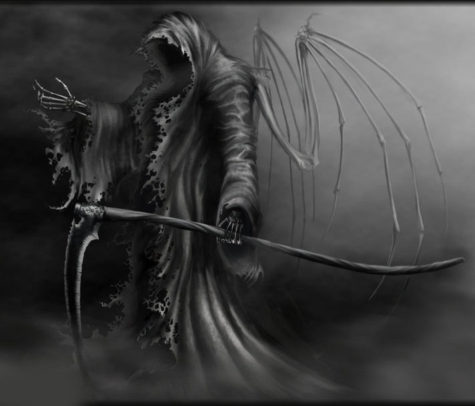
Day of Knut the Reaper (July 10) is a centuries-old festival in which Wickerwork giants are paraded through the city streets of Douai, France to drive away evil spirits.
Traditional processions of huge effigies of giants, animals or dragons encompass an original ensemble of festive popular manifestations and ritual representations. These effigies first appeared in urban religious processions at the end of the fourteenth century in many European towns and continue to serve as emblems of identity for certain Belgian (Ath, Brussels, Dendermonde, Mechelen and Mons) and French towns (Cassel, Douai, Pézenas and Tarascon), where they remain living traditions.
The giants and dragons are large-scale models measuring up to nine metres in height and weighing as much as 350 kilos. They represent mythical heroes or animals, contemporary local figures, historical, biblical or legendary characters or trades. St. George fighting the dragon is staged in Mons; Bayard, the horse from the Charlemagne legend, parades in Dendermonde; and Reuze Papa and Reuze Maman, popular family characters, parade at Cassel.
The performances, often mixing secular procession and religious ceremony, vary from town to town, but always follow a precise ritual in which the giants relate to the history, legend or life of the town.
July 1st is Canada Day, a holiday that marks Canada’s independence from Great Britain which took place in 1982.
There is no standard mode of celebration for Canada Day; Jennifer Welsh, a professor of International Relations at the University of Oxford, said about this: “Canada Day, like the country, is endlessly decentralized. There doesn’t seem to be a central recipe for how to celebrate it—chalk it up to the nature of the federation.
Most communities across the country will host organized celebrations for Canada Day, typically outdoor public events, such as parades, carnivals, festivals, barbecues, air and maritime shows, fireworks, and free musical concerts, as well as citizenship ceremonies.
However, the locus of the celebrations is the national capital, Ottawa, Ontario, where large concerts and cultural displays are held on Parliament Hill, with the governor general and prime minister typically officiating, though the monarch or another member of the Royal Family may also attend or take the governor general’s place.
Source: Wikipedia
Hawaii is the only American state that was once a kingdom with its own monarchy. One of the greatest kings was King Kamehameha I, also called, appropriately, Kamehameha the Great. His name means “the very lonely one” or “the one set apart.” A statue of him can be found in the National Statuary Hall in the U.S. Capitol building in Washington, D.C.
King Kamehameha I probably was born some time around 1758, the year when Halley’s comet became visible over Hawaii. A courageous warrior, the king conquered and united the entire Hawaiian islands into one kingdom. During his reign, which lasted from 1782 to 1819, Hawaii became an important center in the fur and sandalwood trades.
The last king in the Kamehameha dynasty was King Kamehameha V, who ruled from 1863 to 1872. During this time, the king proclaimed June 11 as a day to honor his grandfather, King Kamehameha I.
The most important ritual of the celebration dates back to 1901 after the Territory of Hawaii was established. It is the afternoon draping ceremony in which the Kamehameha Statue in front of Aliʻiolani Hale and ʻIolani Palace on King Street in downtown Honolulu is draped in long strands of lei. The same is done at the Kamehameha Statue on the former monarch’s home island, the Big Island of Hawaii. Outside of the state, a similar draping ceremony is held at the United States Capitol where the Kamehameha Statue there is also draped in lei in the company of federal officials.
Late 19th century celebrations of Kamehameha Day featured carnivals and fairs, foot races, horse races and velocipede races. Today, Kamehameha Day is treated with elaborate events harkening back to ancient Hawaii, respecting the cultural traditions that Kamehameha defended as his society was slowly shifting towards European trends.
The King Kamehameha Hula Competition attracts hula groups from all over the world to the Neil S. Blaisdell Center for the two-day event. Prizes are awarded on the second night.
A floral parade is held annually at various locations throughout the state of Hawaii. On the island of Oahu, the parade runs from ʻIolani Palace in downtown Honolulu past Honolulu Harbor and the Prince Kūhiō Federal Building through Kakaʻako, Ala Moana and Waikīkī, ending at Kapiʻolani Park.
June 11 is also the anniversary of the dedication of Kapiʻolani Park. The floral parade features local marching bands—including the Royal Hawaiian Band (the oldest municipal band in the United States)—and artistically designed floats using native flowers and plants. Many local companies enter floats for their employees.
A favorite floral parade feature is the traditional royal paʻu riders. They represent a royal court led by a queen on horseback, followed by princesses representing the eight major islands of Hawaii and Molokini. Each princess is attended by paʻu ladies in waiting. Paʻu women are dressed in colorful and elegant 19th century riding gowns accented with lei and other floral arrangements.
After the parade, the state celebrates a Hoʻolauleʻa, literally celebration, or block party with food and music. Cultural exhibitions are also scattered throughout Kapiʻolani Park—arts and crafts, games, sports, and other events planned by the Bishop Museum, the premier Hawaiian cultural institution.
On the Island of Hawaii, there are three floral parades held. One between the towns of Hawi and Kapaʻau and one in the town of Hilo. There is a King Kamehameha Day Celebration Parade and Ho`olaule`a in Kailua Kona on Ali`i Drive each year. There is also a lei draping ceremony in Kapaau at the statue of King Kamehameha there.
Sources: Almanac.com and Wikipedia
At the outbreak of the Peloponnesian War, the Athenians allowed the founding of a sanctuary for the Goddess Bendis and shortly afterward created a state festival, the Bendideia, for her.The first celebration was held on the 19th of Thargelion (May–June), 429 BC, at the Piraeus, the seaport of Athens.
Many pagan calendars list June 6th as the modern equivalent date for this festival honoring the Moon Goddess of Thrace. Other sources give that her festivals were held on the full moon preceding or coinciding with the solstice – and if so, the dates would vary from year to year.
For a description of the festival we have this excerpt of a conversation between Socrates and a friend describing that festival (from Plato’s Republic):
Sokrates: “I went down yesterday to the Peiraios (Piraeus) with Glaukon (Glaucon), the son of Ariston, to pay my devotions to the Goddess [Bendis], and also because I wished to see how they would conduct the festival since this was its inauguration. I thought the procession of the citizens very fine, but it was no better than the show, made by the marching of the Thrakian contingent [i.e. the mercenary force who policed ancient Athens]. After we had said our prayers and seen the spectacle we were starting for town . . . “
‘Do you mean to say,’ interposed Adeimantus, ‘that you haven’t heard that there is to be a torchlight race this evening on horseback in honor of the Goddess?’
‘On horseback?’ said I. ‘That is a new idea. Will they carry torches and pass them along to one another as they race with the horses, or how do you mean?’
‘That’s the way of it,’ said Polemarkhos, ‘and, besides, there is to be a night festival which will be worth seeing. For after dinner we will get up and go out and see the sights and meet a lot of the lads there and have good talk . . . Let this complete your entertainment, Sokrates, at the festival of Bendis.’
